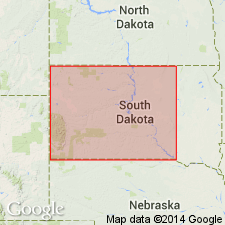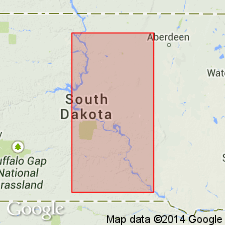
- Usage in publication:
-
- Agency-Oacoma zone (informal)
- Modifications:
-
- Revised
- Dominant lithology:
-
- Shale
- Bentonite
- AAPG geologic province:
-
- Williston basin
- Sioux uplift
Summary:
Pg. 6 (fig. 2), 16-18. [/]Agency-Oacoma zone (informal) in Sully member of Pierre formation. Along Missouri River Valley, South Dakota, not possible to draw line between true Agency and banded beds in type locality of Searight's (1937) Oacoma zone, thus it is suggested that both terms be retained, and that all beds between Crow Creek zone and Verendrye zone be referred to as the Agency-Oacoma zone. Consists of gray, dominantly siliceous shale with many bentonites; manganese-iron concretions locally abundant. Thickness 23 to 124 feet. [Age is Late Cretaceous.]
Source: Publication.

- Usage in publication:
-
- Agency-Oacoma zone (informal)†
- Modifications:
-
- Abandoned
- AAPG geologic province:
-
- Sioux uplift
- Williston basin
Summary:
Pg. 2340 (table 10), 2341, 2343. Rocks of †Agency-Oacoma zone of Gries (1942) reallocated to DeGrey member (new) of Pierre shale.
Source: Modified from US geologic names lexicon (USGS Bull. 1200, p. 25, Oacoma entry p. 2786).
For more information, please contact Nancy Stamm, Geologic Names Committee Secretary.
Asterisk (*) indicates published by U.S. Geological Survey authors.
"No current usage" (†) implies that a name has been abandoned or has fallen into disuse. Former usage and, if known, replacement name given in parentheses ( ).
Slash (/) indicates name conflicts with nomenclatural guidelines (CSN, 1933; ACSN, 1961, 1970; NACSN, 1983, 2005, 2021). May be explained within brackets ([ ]).

